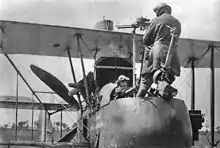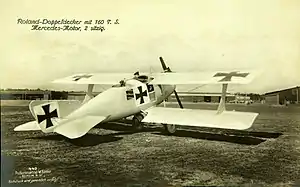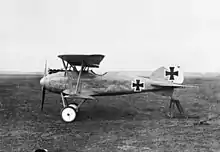Charles Henry Chapman Woollven | |
|---|---|
| Born | 28 June 1897 Folkestone, Kent, England |
| Died | 7 January 1971 (aged 73) |
| Allegiance | United Kingdom |
| Service/ | British Army Royal Flying Corps Royal Air Force |
| Years of service | 1916–1947 |
| Rank | Group captain |
| Unit | Devonshire Regiment No. 25 Squadron RFC |
| Battles/wars | World War I • Western Front World War II |
| Awards | Order of the British Empire Military Cross |
Group Captain Charles Henry Chapman Woollven OBE, MC (28 June 1897 – 7 January 1971) was a British professional soldier who began his military career during World War I. He became a flying ace credited with five aerial victories while piloting a two-seater FE.2b into combat. Postwar, he remained in the Royal Air Force, rising through the officer's ranks while holding increasingly more important posts during the 1920s and 1930s. By 1938, on the eve of World War II, he was a wing commander. Promoted to the rank of group captain by war's end, he retired in 1947.
Personal details
Charles Henry Chapman Woollven was born on 28 June 1897;[1] his birthplace is given as either Plymouth, England,[2] or Folkestone.[1]
On 6 August 1925, he married Ariel Gwynnedd Alice Jeffery at Holy Trinity, Paddington.[3]
World War I
On 26 January 1916, Woollven was commissioned from the Royal Military College, Sandhurst as a second lieutenant in the Devonshire Regiment.[4] He was promptly seconded to the Royal Flying Corps to begin his flight training, being granted Royal Aero Club Aviator's Certificate No. 2636 on 31 March,[1] and was appointed a flying officer on 27 May.[5] He joined No. 25 Squadron RFC on 19 June 1916 to fly a F.E.2b two-seater.[2] He scored his first victory on 8 August, driving down a Roland C.II out of control.[1][2]
Woollven was awarded the Military Cross, which was gazetted on 14 November 1916. His citation read:
- Second Lieutenant Charles Henry Chapman Woollven, Devonshire Regiment and Royal Flying Corps.
- "For conspicuous gallantry in action. He dived down to a low altitude, attacked a train, causing many casualties, and displayed great courage and determination throughout."[6]

He quickly followed this with more aerial victories, destroying two Albatros D.I fighters, on 16 and 23 November.[1] He was appointed a flight commander with the temporary rank of captain on 31 December 1916.[7] On 17 March 1917 he drove down out of control an Albatros D.II fighter, and on 1 May he destroyed an Albatros D.III for his fifth victory.[1][2] On 26 July 1917 Woollven was promoted to lieutenant.[8]
List of aerial victories
| No. | Date/Time | Aircraft/ Serial No. |
Opponent | Result | Location | Notes |
|---|---|---|---|---|---|---|
| 1 | 8 August 1916 @ 0640 | F.E.2b (6991) | Roland C.II | Out of control | Don | Observer: Lieutenant C. Nelson. |
| 2 | 16 November 1916 @ 1300 | F.E.2b (7024) | Albatros D.I | Destroyed | Somain | Observer: Second Lieutenant C. H. Marchant. |
| 3 | 23 November 1916 @ 1545 | F.E.2b (7024) | Albatros D.I | Destroyed | East of Oppy | Observer: Sergeant G. R. Horrocks. |
| 4 | 17 March 1917 @ 1100–1130 | F.E.2b (A5484) | Albatros D.II | Out of control | Oppy—Beaumont | Observer: Sergeant J. H. Booth. |
| 5 | 1 May 1917 @ 1800 | F.E.2b (7003) | Albatros D.III | Destroyed | South-east of Fresnoy | Observer: Sergeant J. H. Booth. |


Inter-war career
On 20 January 1919 Woollven was transferred to the RAF's Administrative Branch,[9] and was granted a permanent commission in the RAF as a captain on 1 August 1919.[10] He served first overseas, as he was posted to the RAF Depot on transfer to the Home Establishment on 21 October 1923.[11] He served at the Inland Area Aircraft Depot at RAF Henlow from 14 January 1924.[12]
On 1 January 1931, he was promoted to squadron leader,[13] and on 8 April was posted to No. 4 Flying Training School at RAF Abu Sueir in Egypt,[14] where he remained until 10 October 1933.[15] Placed on half pay, he was reactivated on 22 June 1934,[16] and posted to No. 2 Flying Training School at RAF Digby for administrative duties on 10 November,[17] then to the RAF Record Office at RAF West Ruislip on 11 August 1938.[18] On 29 November 1938 he was promoted to wing commander.[19]
World War II and beyond
On 11 June 1942 in the King's Birthday Honours, Woollven, now an acting group captain, was made an Officer of the Order of the British Empire.[20] He was promoted to the temporary rank of group captain on 1 January 1943,[21] and eventually retired on 15 September 1947 retaining that rank.[22]
Charles Henry Chapman Woollven died on 7 January 1971.[1]
References
- Notes
- 1 2 3 4 5 6 7 8 "Charles Henry Chapman Woollven". The Aerodrome. 2016. Retrieved 27 April 2016.
- 1 2 3 4 5 Shores, Franks & Guest (1990), p. 390.
- ↑ "Personals: Married". Flight. XVII (871): 569. 3 September 1925. Retrieved 27 April 2016.
- ↑ "No. 29450". The London Gazette. 25 January 1916. p. 1007.
- ↑ "No. 29625". The London Gazette. 16 June 1916. p. 5984.
- ↑ "No. 29824". The London Gazette (Supplement). 14 November 1916. p. 11071.
- ↑ "No. 29899". The London Gazette (Supplement). 9 January 1917. p. 472.
- ↑ "No. 30552". The London Gazette (Supplement). 1 March 1918. p. 2691.
- ↑ "No. 31223". The London Gazette. 11 March 1919. p. 3297.
- ↑ "No. 31486". The London Gazette. 1 August 1919. p. 9867.
- ↑ "Royal Air Force: Appointments". Flight. XV (778): 731. 22 November 1923. Retrieved 27 April 2016.
- ↑ "Royal Air Force: Appointments". Flight. XVI (785): 27. 10 January 1924. Retrieved 27 April 2016.
- ↑ "No. 33675". The London Gazette (Supplement). 30 December 1930. p. 17.
- ↑ "Royal Air Force: Appointments". Flight. XXIII (1181): 823. 14 August 1931. Retrieved 27 April 2016.
- ↑ "Royal Air Force: Appointments". Flight. XXV (1296): 1083. 26 October 1933. Retrieved 27 April 2016.
- ↑ "London Gazette, 10 July 1934" (PDF). The Gazette. Retrieved 17 November 2020.
- ↑ "Royal Air Force: Appointments". Flight. XXVI (1352): 1263. 22 November 1934. Retrieved 27 April 2016.
- ↑ "Royal Air Force: Appointments". Flight. XXXIV (1549): 189. 1 September 1938. Retrieved 27 April 2016.
- ↑ "No. 34575". The London Gazette. 29 November 1938. p. 7533.
- ↑ "No. 35586". The London Gazette. 5 June 1942. p. 2487.
- ↑ "No. 35855". The London Gazette. 5 January 1943. p. 216.
- ↑ "No. 38071". The London Gazette (Supplement). 12 September 1947. p. 4335.
- Bibliography
- Shores, Christopher F.; Franks, Norman & Guest, Russell F. (1990). Above the Trenches: a Complete Record of the Fighter Aces and Units of the British Empire Air Forces 1915–1920. London, UK: Grub Street. ISBN 978-0-948817-19-9.